Garden Seeds Market
Garden Seeds Market Size and Share Forecast Outlook 2025 to 2035
Garden seeds market is projected to grow from USD 3,700.0 million in 2025 to USD 5,400.0 million by 2035, at a CAGR of 3.9%. Vegetable will dominate with a 50.0% market share, while household will lead the user segment with a 65.0% share.
Garden Seeds Market Forecast and Outlook 2025 to 2035
The global garden seeds market is projected to grow from USD 3,700.0 million in 2025 to approximately USD 5,400.0 million by 2035, recording an absolute increase of USD 1,700.0 million over the forecast period. This translates into a total growth of 45.9%, with the market forecast to expand at a compound annual growth rate (CAGR) of 3.9% between 2025 and 2035.
The overall market size is expected to grow by nearly 1.5X during the same period, supported by increasing global demand for home gardening activities, growing adoption of organic farming practices, and rising interest in fresh produce cultivation driving premium seed procurement across various gardening and agricultural applications.
Quick Stats for Garden Seeds Market
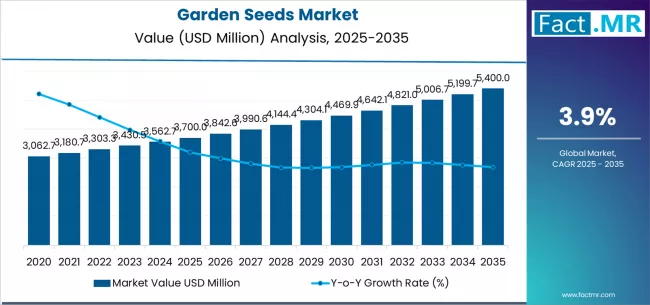
| Garden Seeds Market Value (2025) | USD 3,700.0 million |
|---|---|
| Garden Seeds Market Forecast Value (2035) | USD 5,400.0 million |
| Garden Seeds Market CAGR | 3.9% |
| Leading Segment by Type (2025) | Vegetable (50.0%) |
| Leading Segment by User (2025) | Household (65.0%) |
| Leading Segment by Channel (2025) | Retail (70.0%) |
| Key Growth Regions | Asia Pacific, North America, and Europe |
| Top Companies by Market Share | Burpee, Syngenta, Sakata |
Garden Seeds Market Key Takeaways
| Metric | Value |
|---|---|
| Market Value (2025) | USD 3,700.0 million |
| Market Forecast Value (2035) | USD 5,400.0 million |
| Forecast CAGR (2025-2035) | 3.9% |
Why is the Garden Seeds Market Growing?
| CONSUMER & LIFESTYLE TRENDS | AGRICULTURAL REQUIREMENTS | REGULATORY & QUALITY STANDARDS |
|---|---|---|
| Home Gardening Growth Continuous expansion of home gardening activities across established and emerging markets driving demand for high-quality seed varieties delivering precise germination control and enhanced plant performance. Health Consciousness Demographics Growing emphasis on fresh produce consumption and organic gardening practices creating demand for premium seed varieties offering consistent performance while maintaining cultivation efficiency. Premium Gardening Performance Superior germination properties and plant growth characteristics making garden seeds essential for performance-focused horticultural applications across diverse growing environments. | Advanced Cultivation Requirements Modern cultivation practices require high-performance seeds delivering consistent germination rates and enhanced plant vigor characteristics for optimal growing results. Processing Efficiency Demands Gardeners and farmers investing in premium seed varieties offering consistent performance while maintaining processing efficiency throughout growing seasons. Quality and Reliability Standards Certified producers with proven track records required for advanced seed applications delivering consistent performance and reliable yields. | Seed Quality Standards Regulatory requirements establishing performance benchmarks favoring high-quality seed materials with proven genetic integrity. Performance Property Standards Quality standards requiring superior germination properties and resistance to environmental stresses in diverse growing conditions. Agricultural Compliance Requirements Diverse agricultural requirements and quality standards driving need for sophisticated seed varieties with enhanced genetic traits. |
Garden Seeds Market Segmentation
| Category | Segments Covered |
|---|---|
| By Type | Vegetable, Flower, Herbs |
| By User | Household, Commercial |
| By Channel | Retail, Online |
| By Region | North America, Europe, Asia Pacific, Latin America, Middle East & Africa |
Garden Seeds Market Analysis by Type
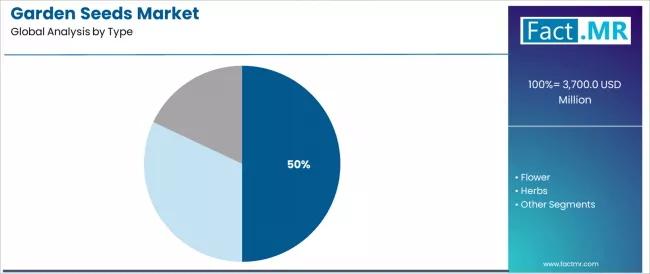
| Segment | 2025 to 2035 Outlook |
|---|---|
| Vegetable | Leader in 2025 with 50.0% market share; likely to maintain leadership through 2035. Broadest use in home gardens, commercial farming, and urban agriculture applications, mature supply chain, predictable functionality. Momentum: steady-to-strong. Watchouts: climate change affecting growing patterns. |
| Flower | Strong segment for ornamental applications with established demand in landscaping and home gardening sectors. Processing complexity balanced with aesthetic value for decorative growing applications. Momentum: steady in residential applications; moderate growth in commercial landscaping segments. |
| Herbs | Benefiting from culinary and medicinal gardening trends due to specialized growing properties and enhanced flavor characteristics. Momentum: rising. Watchouts: seasonal demand fluctuations, technical growing requirements. |
Garden Seeds Market Analysis by User
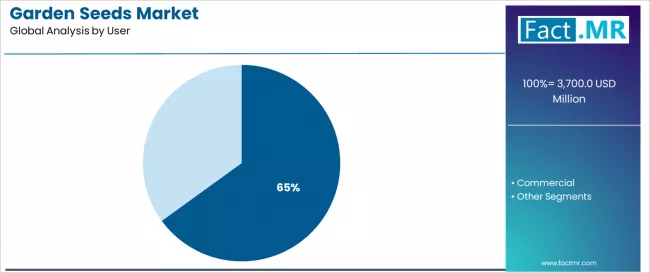
| Segment | 2025 to 2035 Outlook |
|---|---|
| Household | At 65.0%, largest user segment in 2025 with established home gardening integration. Mature distribution channels, standardized packaging specifications. Momentum: steady growth driven by home gardening trends and fresh produce demand. Watchouts: seasonal purchasing patterns affecting demand consistency. |
| Commercial | Strong growth segment driven by professional farming and landscaping demand. Vegetable and flower seeds dominate commercial applications. Momentum: strong growth through 2030, supported by agricultural expansion. Watchouts: competition from alternative growing methods. |
Garden Seeds Market Analysis by Channel
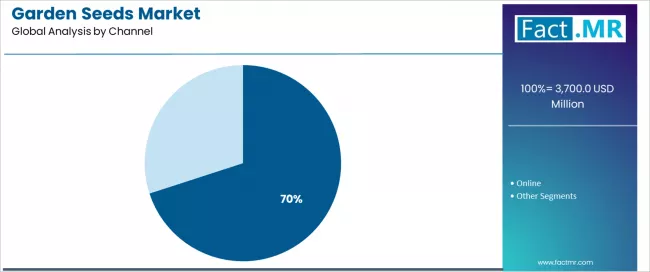
| Channel | Status & Outlook 2025-2035 |
|---|---|
| Retail | Dominant channel in 2025 with 70.0% share for consumer applications. Physical store presence, customer service advantages, immediate availability. Momentum: steady growth driven by traditional shopping preferences and expert guidance. Watchouts: competition from online channels. |
| Online | Important for convenience applications requiring broad selection. Value-add through product variety, customer reviews, specialized growing information. Momentum: strong growth as digital adoption increases. Geographic reach advantages supporting market expansion. |
DRIVERS
| DRIVERS | RESTRAINTS | KEY TRENDS |
|---|---|---|
| Home Gardening Interest Growth Continuing expansion of home gardening activities across established and emerging markets driving demand for high-quality seed varieties with reliable germination and plant performance characteristics. Fresh Produce Awareness Increasing adoption of fresh produce cultivation and organic growing methods importance in nutritional quality and food security optimization across diverse growing environments. Premium Gardening Demand Growing demand for specialty seeds that support both performance benefits and growing efficiency in home gardening and commercial agricultural applications. | Climate Variability Weather pattern changes affecting growing success and seed performance reliability for gardeners and farmers. Growing Complexity Complex growing requirements across applications affecting product development and standardization for diverse climate conditions. Technical Growing Requirements Complex technical requirements across applications affecting product development and cultivation standardization. Competition from Alternatives Alternative growing methods affecting market selection and development including hydroponic and controlled environment systems. | Advanced Seed Technologies Integration of advanced seed development systems, genetic improvements, and quality control solutions enabling superior germination efficiency. Performance Enhancement Enhanced germination control, improved plant vigor, and advanced genetic capabilities compared to traditional seed varieties. Specialized Varieties Development of specialized seed varieties and custom formulations providing enhanced performance benefits and application-specific optimization. Technical Innovation Integration of advanced seed development and intelligent growing management for sophisticated horticultural solutions. |
Analysis of Garden Seeds Market by Key Countries
| Country | CAGR (2025-2035) |
|---|---|
| India | 4.8% |
| China | 4.0% |
| USA | 3.6% |
| UK | 3.4% |
| South Korea | 3.2% |
| Germany | 3.3% |
| Japan | 2.8% |
India Leads Global Market Growth with Agricultural Excellence
Revenue from garden seeds in India is projected to exhibit strong growth driven by expanding agricultural infrastructure and comprehensive home gardening innovation creating substantial opportunities for seed suppliers across vegetable cultivation operations, flower gardening applications, and herb growing sectors.
The country's developing agricultural tradition and expanding farming capabilities are creating significant demand for both conventional and high-performance seed varieties. Major agricultural companies are establishing comprehensive local seed production facilities to support large-scale cultivation operations and meet growing demand for efficient gardening solutions.
- Agricultural industry modernization programs are supporting widespread adoption of advanced seed varieties across farming operations, driving demand for high-quality horticultural products
- Horticultural excellence initiatives and specialized crop development are creating substantial opportunities for seed suppliers requiring reliable germination and cost-effective growing solutions
- Home gardening growth and agricultural processing development are facilitating adoption of specialty seed varieties throughout major rural regions
China Demonstrates Strong Market Potential with Agricultural Processing Growth
Revenue from garden seeds in China is expanding supported by extensive agricultural manufacturing expansion and comprehensive horticultural industry development creating demand for reliable seed varieties across diverse farming categories and specialty growing segments. The country's dominant agricultural production position and expanding farming capabilities are driving demand for seed solutions that provide consistent performance while supporting cost-effective growing requirements. Agricultural processors and farmers are investing in local production facilities to support growing operations and fresh produce demand.
- Agricultural operations expansion and horticultural capability development are creating opportunities for seed varieties across diverse farming segments requiring reliable germination and competitive growing costs
- Farming modernization and growing technology advancement are driving investments in agricultural supply chains supporting performance requirements throughout major rural regions
- Agricultural growth and specialty crop development programs are enhancing demand for cultivation-grade seeds throughout farming production areas
USA Maintains Strong Position with Premium Gardening Innovation
Demand for garden seeds in USA is projected to grow supported by the country's expanding home gardening base and horticultural technologies requiring advanced seed systems for residential cultivation and commercial farming applications. American gardening companies are implementing growing systems that support advanced cultivation techniques, operational efficiency, and comprehensive quality protocols. The market is characterized by focus on operational excellence, horticultural performance, and compliance with agricultural quality standards.
- Premium gardening industry investments are prioritizing advanced growing technologies that demonstrate superior germination and quality while meeting American agricultural standards
- Horticultural leadership programs and operational excellence initiatives are driving adoption of precision-engineered seed varieties that support advanced growing systems and performance optimization
- Research and development programs for plant enhancement are facilitating adoption of specialized cultivation techniques throughout major gardening centers
UK Expands Market with Gardening Innovation
Revenue from garden seeds in UK is growing driven by advanced home gardening development programs and increasing horticultural technology innovation creating opportunities for seed suppliers serving both residential gardening operations and commercial growing contractors. The country's extensive gardening tradition and expanding agricultural awareness are creating demand for seed varieties that support diverse performance requirements while maintaining growing performance standards. Gardening retailers and specialty product service providers are developing procurement strategies to support operational efficiency and regulatory compliance.
- Advanced horticultural development programs and seed manufacturing are facilitating adoption of garden seed varieties capable of supporting diverse germination requirements and competitive growing standards
- Agricultural innovation and performance-focused farming development programs are enhancing demand for cultivation-grade seeds that support operational efficiency and growing reliability
- Premium gardening market expansion and specialty horticultural development are creating opportunities for advanced seed processing capabilities across UK gardening facilities
Germany Focuses on Premium Horticultural Manufacturing
Demand for garden seeds in Germany is projected to grow driven by premium gardening excellence and specialty seed capabilities supporting advanced horticultural development and comprehensive agricultural applications. The country's established farming tradition and growing performance gardening market segments are creating demand for high-quality seed varieties that support operational performance and horticultural standards. Agricultural manufacturers and processing suppliers are maintaining comprehensive development capabilities to support diverse growing requirements.
- Premium horticultural manufacturing and specialty seed programs are supporting demand for cultivation-grade garden seeds that meet contemporary germination and reliability standards
- Agricultural development and performance-focused farming programs are creating opportunities for specialized seed varieties that provide comprehensive horticultural support
- Growing modernization and agricultural quality enhancement programs are facilitating adoption of advanced cultivation capabilities throughout major gardening regions
South Korea Focuses on Advanced Gardening Manufacturing
Demand for garden seeds in South Korea is projected to grow at 3.2% CAGR driven by advanced gardening excellence and specialty seed capabilities supporting horticultural development and comprehensive cultivation applications. The country's established agricultural tradition and growing performance gardening market segments are creating demand for high-quality seed varieties that support operational performance and horticultural standards.
- Advanced gardening manufacturing and specialty seed programs are supporting demand for cultivation-grade garden seeds that meet contemporary germination and reliability standards
- Horticultural development and performance-focused farming programs are creating opportunities for specialized seed varieties that provide comprehensive agricultural support
- Growing modernization and agricultural quality enhancement programs are facilitating adoption of advanced cultivation capabilities throughout major gardening regions
Japan Focuses on Precision Horticultural Manufacturing
Demand for garden seeds in Japan is projected to grow driven by precision gardening excellence and specialty seed capabilities supporting advanced horticultural development and comprehensive technical applications. The country's established agricultural tradition and growing performance gardening market segments are creating demand for high-quality seed varieties that support operational performance and horticultural standards.
- Precision gardening manufacturing and specialty seed programs are supporting demand for cultivation-grade garden seeds that meet contemporary germination and reliability standards
- Horticultural development and performance-focused farming programs are creating opportunities for specialized seed varieties that provide comprehensive agricultural support
- Growing modernization and agricultural quality enhancement programs are facilitating adoption of advanced cultivation capabilities throughout major gardening regions
Europe Market Split by Processing Application
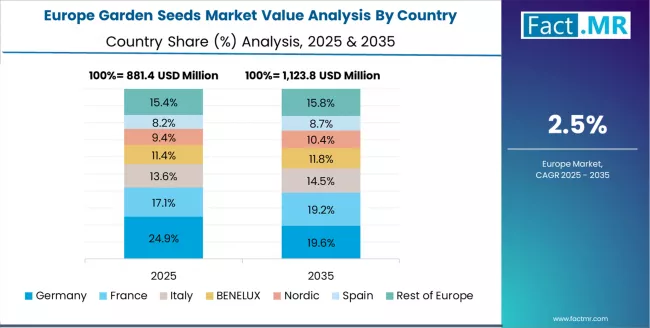
European garden seeds operations are increasingly polarized between Western European precision processing and Eastern European cost-competitive manufacturing. German (USD 780.0 million) and UK facilities (USD 620.0 million) dominate premium home gardening and commercial cultivation seed processing, leveraging advanced horticultural technologies and strict quality protocols that command price premiums in global markets. German processors maintain leadership in high-performance seed applications, with major gardening companies driving technical specifications that smaller suppliers must meet to access supply contracts.
France (USD 540.0 million), Italy (USD 440.0 million), and Spain (USD 380.0 million) operations focus on specialized applications and regional market requirements. Rest of Europe (USD 940.0 million) including Eastern European operations in Poland, Hungary, and Czech Republic are capturing volume-oriented processing contracts through labor cost advantages and EU regulatory compliance, particularly in standard seed varieties for home gardening applications.
The regulatory environment presents both opportunities and constraints. EU seed regulations and agricultural directives create barriers for novel seed varieties but establish quality standards that favor established European processors over imports. Brexit has fragmented UK sourcing from EU suppliers, creating opportunities for direct relationships between processors and British gardening retailers.
Supply chain consolidation accelerates as processors seek economies of scale to absorb rising energy costs and compliance expenses. Vertical integration increases, with major gardening retailers acquiring processing facilities to secure seed supplies and quality control. Smaller processors face pressure to specialize in niche applications or risk displacement by larger, more efficient operations serving mainstream home gardening requirements.
Premium Quality Standards Define Japanese Market Dynamics
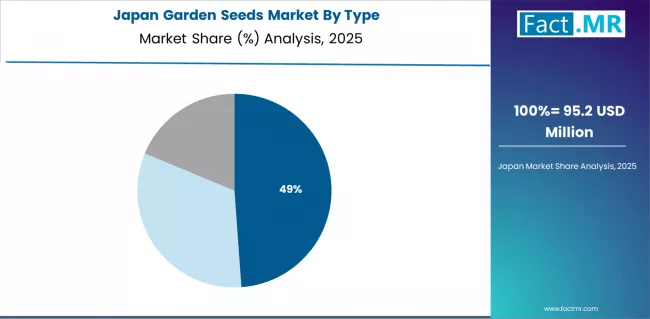
The garden seeds market in Japan reflects exacting quality standards and sophisticated horticultural expectations. Major gardening retailers maintain rigorous supplier qualification processes that often exceed international standards, requiring extensive documentation, batch testing, and facility audits that can take 12-18 months to complete. This creates high barriers for new suppliers but ensures consistent quality that supports premium product positioning.
The Japanese market demonstrates unique application preferences with home gardening accounting for significant demand across diverse cultivation categories. Companies require specific germination ratios and purity specifications that differ from Western applications, driving demand for customized processing capabilities.
Japanese market demonstrates unique type preferences with focus on traditional vegetable varieties and ornamental flowers. Companies require specific genetic characteristics and performance specifications that differ from Western applications, driving demand for customized seed development capabilities.
Regulatory oversight emphasizes comprehensive agricultural management and traceability requirements that surpass most international standards. The seed registration system requires detailed genetic sourcing information, creating advantages for suppliers with transparent supply chains and comprehensive documentation systems.
Supply chain management focuses on relationship-based partnerships rather than purely transactional procurement. Japanese companies typically maintain long-term supplier relationships spanning decades, with annual contract negotiations emphasizing quality consistency over price competition. This stability supports investment in specialized processing equipment tailored to Japanese specifications.
Market Dynamics Drive Innovation in South Korea
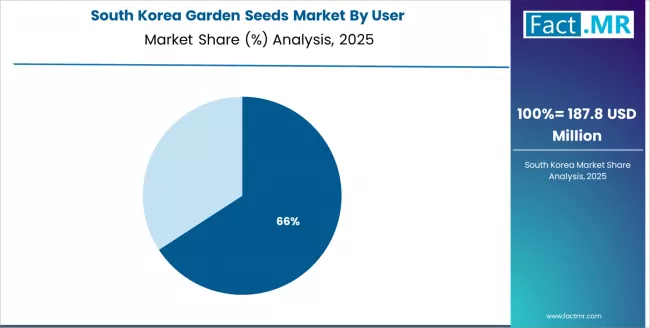
South Korean Garden Seeds operations reflect the country's advanced agricultural sector and export-oriented business model. Major agricultural companies drive sophisticated procurement strategies, establishing direct relationships with global suppliers to secure consistent quality and pricing for their cultivation and gardening operations targeting both domestic and international markets.
The Korean market demonstrates particular strength in household applications, creating demand for specific performance specifications that differ from Western applications, requiring suppliers to adapt cultivation and processing techniques.
Regulatory frameworks emphasize agricultural safety and traceability, with Korean agricultural administration standards often exceeding international requirements. This creates barriers for smaller suppliers but benefits established processors who can demonstrate compliance capabilities. The regulatory environment particularly favors suppliers with comprehensive certification and documentation systems.
Supply chain efficiency remains critical given Korea's geographic limitations and import dependence. Companies increasingly pursue long-term contracts with suppliers in United States, Germany, and Japan to ensure reliable access to seed varieties while managing foreign exchange risks. Technical logistics investments support quality preservation during extended shipping periods.
The market faces pressure from rising labor costs and competition from lower-cost regional manufacturers, driving automation investments and consolidation among smaller processors. However, the premium positioning of Korean agricultural products internationally continues to support demand for high-quality seed varieties that meet stringent specifications.
Competitive Landscape of Garden Seeds Market
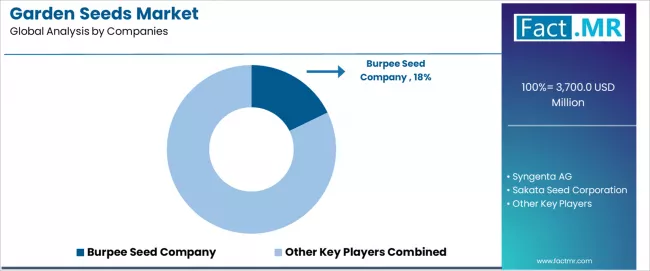
Profit pools are consolidating upstream in scaled seed production systems and downstream in value-added specialty varieties for home gardening, commercial farming, and specialty cultivation applications where certification, traceability, and consistent germination command premiums. Value is migrating from raw seed commodity trading to specification-tight, application-ready varieties where technical expertise and quality control drive competitive advantage.
Several archetypes set the pace: global agricultural integrators defending share through production scale and technical reliability; multi-variety processors that manage complexity and serve diverse applications; specialty seed developers with cultivation expertise and gardening industry ties; and performance-driven suppliers pulling volume in premium gardening and agricultural applications.
Switching costs - re-qualification, germination testing, performance validation, provide stability for incumbents, while supply shocks and regulatory changes reopen opportunities for diversified suppliers. Consolidation and verticalization continue; digital procurement emerges in commodity grades while premium specifications remain relationship led.
Focus areas: lock gardening and agriculture pipelines with application-specific varieties and service level agreements; establish multi-variety production capabilities and technical disclosure; develop specialized seed formulations with performance claims.
| Stakeholder Type | Primary Advantage | Repeatable Plays |
|---|---|---|
| Global agricultural integrators | Scale, production integration, technical reliability | Long-term contracts, tight specs, co-development with gardening/agriculture |
| Multi-variety processors | Variety diversification, application expertise, supply flexibility | Multi-application serving, technical support, quality assurance across segments |
| Specialty seed developers | Cultivation expertise and industry relationships | Custom varieties, performance science, growing SLAs |
| Performance suppliers | Application-focused demand and specialized service | Technical performance claims, specialized varieties, application activation |
| Agricultural distributors & platforms | Technical support for mid-tier manufacturers | Variety selection, smaller volumes, technical service |
Key Players in the Garden Seeds Market
- Burpee Seed Company
- Syngenta AG
- Sakata Seed Corporation
- Takii & Co. Ltd.
- Bayer AG (Seeds division)
- Bejo Zaden B.V.
- Rijk Zwaan Zaadteelt en Zaadhandel B.V.
- Johnny’s Selected Seeds LLC
- HM.CLAUSE S.A.
- PanAmerican Seed Company
- East-West Seed International Ltd.
- Seminis Inc. (subsidiary of Bayer AG)
- Floranova Group
- Thompson & Morgan Ltd.
- Harris Seeds Inc.
Scope of the Report
| Items | Values |
|---|---|
| Quantitative Units (2025) | USD 3,700.0 Million |
| Product | Vegetable, Flower, Herbs |
| User | Household, Commercial |
| Channel | Retail, Online |
| Regions Covered | North America, Europe, Asia Pacific, Latin America, Middle East & Africa |
| Countries Covered | United States, Germany, China, Japan, India, South Korea, UK, and other 40+ countries |
| Key Companies Profiled | Burpee, Syngenta, Sakata, Takii, Bayer, Bejo Zaden, Rijk Zwaan, Johnny's Selected Seeds, HM Clause, PanAmerican Seed, East-West Seed, Seminis, Floranova, Thompson & Morgan, Harris Seeds |
| Additional Attributes | Dollar sales by product/user/channel, regional demand (NA, EU, APAC), competitive landscape, retail vs. online adoption, production/processing integration, and advanced cultivation innovations driving germination enhancement, technical advancement, and efficiency |
Garden Seeds Market Segmentation
-
By Type :
- Vegetable
- Flower
- Herbs
-
By User :
- Household
- Commercial
-
By Channel :
- Retail
- Online
-
By Region :
- North America
- Europe
- Asia Pacific
- Latin America
- Middle East & Africa
Table of Content
- Executive Summary
- Global Market Outlook
- Demand to side Trends
- Supply to side Trends
- Technology Roadmap Analysis
- Analysis and Recommendations
- Market Overview
- Market Coverage / Taxonomy
- Market Definition / Scope / Limitations
- Market Background
- Market Dynamics
- Drivers
- Restraints
- Opportunity
- Trends
- Scenario Forecast
- Demand in Optimistic Scenario
- Demand in Likely Scenario
- Demand in Conservative Scenario
- Opportunity Map Analysis
- Product Life Cycle Analysis
- Supply Chain Analysis
- Investment Feasibility Matrix
- Value Chain Analysis
- PESTLE and Porter’s Analysis
- Regulatory Landscape
- Regional Parent Market Outlook
- Production and Consumption Statistics
- Import and Export Statistics
- Market Dynamics
- Global Market Analysis 2020 to 2024 and Forecast, 2025 to 2035
- Historical Market Size Value (USD Million) Analysis, 2020 to 2024
- Current and Future Market Size Value (USD Million) Projections, 2025 to 2035
- Y to o to Y Growth Trend Analysis
- Absolute $ Opportunity Analysis
- Global Market Pricing Analysis 2020 to 2024 and Forecast 2025 to 2035
- Global Market Analysis 2020 to 2024 and Forecast 2025 to 2035, By Type
- Introduction / Key Findings
- Historical Market Size Value (USD Million) Analysis By Type , 2020 to 2024
- Current and Future Market Size Value (USD Million) Analysis and Forecast By Type , 2025 to 2035
- Vegetable
- Flower
- Herbs
- Y to o to Y Growth Trend Analysis By Type , 2020 to 2024
- Absolute $ Opportunity Analysis By Type , 2025 to 2035
- Global Market Analysis 2020 to 2024 and Forecast 2025 to 2035, By User
- Introduction / Key Findings
- Historical Market Size Value (USD Million) Analysis By User, 2020 to 2024
- Current and Future Market Size Value (USD Million) Analysis and Forecast By User, 2025 to 2035
- Household
- Commercial
- Y to o to Y Growth Trend Analysis By User, 2020 to 2024
- Absolute $ Opportunity Analysis By User, 2025 to 2035
- Global Market Analysis 2020 to 2024 and Forecast 2025 to 2035, By Channel
- Introduction / Key Findings
- Historical Market Size Value (USD Million) Analysis By Channel, 2020 to 2024
- Current and Future Market Size Value (USD Million) Analysis and Forecast By Channel, 2025 to 2035
- Retail
- Online
- Y to o to Y Growth Trend Analysis By Channel, 2020 to 2024
- Absolute $ Opportunity Analysis By Channel, 2025 to 2035
- Global Market Analysis 2020 to 2024 and Forecast 2025 to 2035, By Region
- Introduction
- Historical Market Size Value (USD Million) Analysis By Region, 2020 to 2024
- Current Market Size Value (USD Million) Analysis and Forecast By Region, 2025 to 2035
- North America
- Latin America
- Western Europe
- Eastern Europe
- East Asia
- South Asia and Pacific
- Middle East & Africa
- Market Attractiveness Analysis By Region
- North America Market Analysis 2020 to 2024 and Forecast 2025 to 2035, By Country
- Historical Market Size Value (USD Million) Trend Analysis By Market Taxonomy, 2020 to 2024
- Market Size Value (USD Million) Forecast By Market Taxonomy, 2025 to 2035
- By Country
- USA
- Canada
- Mexico
- By Type
- By User
- By Channel
- By Country
- Market Attractiveness Analysis
- By Country
- By Type
- By User
- By Channel
- Key Takeaways
- Latin America Market Analysis 2020 to 2024 and Forecast 2025 to 2035, By Country
- Historical Market Size Value (USD Million) Trend Analysis By Market Taxonomy, 2020 to 2024
- Market Size Value (USD Million) Forecast By Market Taxonomy, 2025 to 2035
- By Country
- Brazil
- Chile
- Rest of Latin America
- By Type
- By User
- By Channel
- By Country
- Market Attractiveness Analysis
- By Country
- By Type
- By User
- By Channel
- Key Takeaways
- Western Europe Market Analysis 2020 to 2024 and Forecast 2025 to 2035, By Country
- Historical Market Size Value (USD Million) Trend Analysis By Market Taxonomy, 2020 to 2024
- Market Size Value (USD Million) Forecast By Market Taxonomy, 2025 to 2035
- By Country
- Germany
- UK
- Italy
- Spain
- France
- Nordic
- BENELUX
- Rest of Western Europe
- By Type
- By User
- By Channel
- By Country
- Market Attractiveness Analysis
- By Country
- By Type
- By User
- By Channel
- Key Takeaways
- Eastern Europe Market Analysis 2020 to 2024 and Forecast 2025 to 2035, By Country
- Historical Market Size Value (USD Million) Trend Analysis By Market Taxonomy, 2020 to 2024
- Market Size Value (USD Million) Forecast By Market Taxonomy, 2025 to 2035
- By Country
- Russia
- Poland
- Hungary
- Balkan & Baltic
- Rest of Eastern Europe
- By Type
- By User
- By Channel
- By Country
- Market Attractiveness Analysis
- By Country
- By Type
- By User
- By Channel
- Key Takeaways
- East Asia Market Analysis 2020 to 2024 and Forecast 2025 to 2035, By Country
- Historical Market Size Value (USD Million) Trend Analysis By Market Taxonomy, 2020 to 2024
- Market Size Value (USD Million) Forecast By Market Taxonomy, 2025 to 2035
- By Country
- China
- Japan
- South Korea
- By Type
- By User
- By Channel
- By Country
- Market Attractiveness Analysis
- By Country
- By Type
- By User
- By Channel
- Key Takeaways
- South Asia and Pacific Market Analysis 2020 to 2024 and Forecast 2025 to 2035, By Country
- Historical Market Size Value (USD Million) Trend Analysis By Market Taxonomy, 2020 to 2024
- Market Size Value (USD Million) Forecast By Market Taxonomy, 2025 to 2035
- By Country
- India
- ASEAN
- Australia & New Zealand
- Rest of South Asia and Pacific
- By Type
- By User
- By Channel
- By Country
- Market Attractiveness Analysis
- By Country
- By Type
- By User
- By Channel
- Key Takeaways
- Middle East & Africa Market Analysis 2020 to 2024 and Forecast 2025 to 2035, By Country
- Historical Market Size Value (USD Million) Trend Analysis By Market Taxonomy, 2020 to 2024
- Market Size Value (USD Million) Forecast By Market Taxonomy, 2025 to 2035
- By Country
- Kingdom of Saudi Arabia
- Other GCC Countries
- Turkiye
- South Africa
- Other African Union
- Rest of Middle East & Africa
- By Type
- By User
- By Channel
- By Country
- Market Attractiveness Analysis
- By Country
- By Type
- By User
- By Channel
- Key Takeaways
- Key Countries Market Analysis
- USA
- Pricing Analysis
- Market Share Analysis, 2024
- By Type
- By User
- By Channel
- Canada
- Pricing Analysis
- Market Share Analysis, 2024
- By Type
- By User
- By Channel
- Mexico
- Pricing Analysis
- Market Share Analysis, 2024
- By Type
- By User
- By Channel
- Brazil
- Pricing Analysis
- Market Share Analysis, 2024
- By Type
- By User
- By Channel
- Chile
- Pricing Analysis
- Market Share Analysis, 2024
- By Type
- By User
- By Channel
- Germany
- Pricing Analysis
- Market Share Analysis, 2024
- By Type
- By User
- By Channel
- UK
- Pricing Analysis
- Market Share Analysis, 2024
- By Type
- By User
- By Channel
- Italy
- Pricing Analysis
- Market Share Analysis, 2024
- By Type
- By User
- By Channel
- Spain
- Pricing Analysis
- Market Share Analysis, 2024
- By Type
- By User
- By Channel
- France
- Pricing Analysis
- Market Share Analysis, 2024
- By Type
- By User
- By Channel
- India
- Pricing Analysis
- Market Share Analysis, 2024
- By Type
- By User
- By Channel
- ASEAN
- Pricing Analysis
- Market Share Analysis, 2024
- By Type
- By User
- By Channel
- Australia & New Zealand
- Pricing Analysis
- Market Share Analysis, 2024
- By Type
- By User
- By Channel
- China
- Pricing Analysis
- Market Share Analysis, 2024
- By Type
- By User
- By Channel
- Japan
- Pricing Analysis
- Market Share Analysis, 2024
- By Type
- By User
- By Channel
- South Korea
- Pricing Analysis
- Market Share Analysis, 2024
- By Type
- By User
- By Channel
- Russia
- Pricing Analysis
- Market Share Analysis, 2024
- By Type
- By User
- By Channel
- Poland
- Pricing Analysis
- Market Share Analysis, 2024
- By Type
- By User
- By Channel
- Hungary
- Pricing Analysis
- Market Share Analysis, 2024
- By Type
- By User
- By Channel
- Kingdom of Saudi Arabia
- Pricing Analysis
- Market Share Analysis, 2024
- By Type
- By User
- By Channel
- Turkiye
- Pricing Analysis
- Market Share Analysis, 2024
- By Type
- By User
- By Channel
- South Africa
- Pricing Analysis
- Market Share Analysis, 2024
- By Type
- By User
- By Channel
- USA
- Market Structure Analysis
- Competition Dashboard
- Competition Benchmarking
- Market Share Analysis of Top Players
- By Regional
- By Type
- By User
- By Channel
- Competition Analysis
- Competition Deep Dive
- Burpee Seed Company
- Overview
- Product Portfolio
- Profitability by Market Segments (Product/Age /Sales Channel/Region)
- Sales Footprint
- Strategy Overview
- Marketing Strategy
- Product Strategy
- Channel Strategy
- Syngenta AG
- Sakata Seed Corporation
- Takii & Co., Ltd.
- Bayer AG (Seeds division)
- Bejo Zaden B.V.
- Rijk Zwaan Zaadteelt en Zaadhandel B.V.
- Johnny’s Selected Seeds, LLC
- HM.CLAUSE S.A.
- PanAmerican Seed Company
- East-West Seed International, Ltd.
- Seminis, Inc. (subsidiary of Bayer AG)
- Floranova Group
- Thompson & Morgan Ltd.
- Harris Seeds, Inc.
- Burpee Seed Company
- Competition Deep Dive
- Assumptions & Acronyms Used
- Research Methodology
List Of Table
- Table 1: Global Market Value (USD Million) Forecast by Region, 2020 to 2035
- Table 2: Global Market Value (USD Million) Forecast by Type , 2020 to 2035
- Table 3: Global Market Value (USD Million) Forecast by User, 2020 to 2035
- Table 4: Global Market Value (USD Million) Forecast by Channel, 2020 to 2035
- Table 5: North America Market Value (USD Million) Forecast by Country, 2020 to 2035
- Table 6: North America Market Value (USD Million) Forecast by Type , 2020 to 2035
- Table 7: North America Market Value (USD Million) Forecast by User, 2020 to 2035
- Table 8: North America Market Value (USD Million) Forecast by Channel, 2020 to 2035
- Table 9: Latin America Market Value (USD Million) Forecast by Country, 2020 to 2035
- Table 10: Latin America Market Value (USD Million) Forecast by Type , 2020 to 2035
- Table 11: Latin America Market Value (USD Million) Forecast by User, 2020 to 2035
- Table 12: Latin America Market Value (USD Million) Forecast by Channel, 2020 to 2035
- Table 13: Western Europe Market Value (USD Million) Forecast by Country, 2020 to 2035
- Table 14: Western Europe Market Value (USD Million) Forecast by Type , 2020 to 2035
- Table 15: Western Europe Market Value (USD Million) Forecast by User, 2020 to 2035
- Table 16: Western Europe Market Value (USD Million) Forecast by Channel, 2020 to 2035
- Table 17: Eastern Europe Market Value (USD Million) Forecast by Country, 2020 to 2035
- Table 18: Eastern Europe Market Value (USD Million) Forecast by Type , 2020 to 2035
- Table 19: Eastern Europe Market Value (USD Million) Forecast by User, 2020 to 2035
- Table 20: Eastern Europe Market Value (USD Million) Forecast by Channel, 2020 to 2035
- Table 21: East Asia Market Value (USD Million) Forecast by Country, 2020 to 2035
- Table 22: East Asia Market Value (USD Million) Forecast by Type , 2020 to 2035
- Table 23: East Asia Market Value (USD Million) Forecast by User, 2020 to 2035
- Table 24: East Asia Market Value (USD Million) Forecast by Channel, 2020 to 2035
- Table 25: South Asia and Pacific Market Value (USD Million) Forecast by Country, 2020 to 2035
- Table 26: South Asia and Pacific Market Value (USD Million) Forecast by Type , 2020 to 2035
- Table 27: South Asia and Pacific Market Value (USD Million) Forecast by User, 2020 to 2035
- Table 28: South Asia and Pacific Market Value (USD Million) Forecast by Channel, 2020 to 2035
- Table 29: Middle East & Africa Market Value (USD Million) Forecast by Country, 2020 to 2035
- Table 30: Middle East & Africa Market Value (USD Million) Forecast by Type , 2020 to 2035
- Table 31: Middle East & Africa Market Value (USD Million) Forecast by User, 2020 to 2035
- Table 32: Middle East & Africa Market Value (USD Million) Forecast by Channel, 2020 to 2035
List Of Figures
- Figure 1: Global Market Pricing Analysis
- Figure 2: Global Market Value (USD Million) Forecast 2020-2035
- Figure 3: Global Market Value Share and BPS Analysis by Type , 2025 and 2035
- Figure 4: Global Market Y to o to Y Growth Comparison by Type , 2025-2035
- Figure 5: Global Market Attractiveness Analysis by Type
- Figure 6: Global Market Value Share and BPS Analysis by User, 2025 and 2035
- Figure 7: Global Market Y to o to Y Growth Comparison by User, 2025-2035
- Figure 8: Global Market Attractiveness Analysis by User
- Figure 9: Global Market Value Share and BPS Analysis by Channel, 2025 and 2035
- Figure 10: Global Market Y to o to Y Growth Comparison by Channel, 2025-2035
- Figure 11: Global Market Attractiveness Analysis by Channel
- Figure 12: Global Market Value (USD Million) Share and BPS Analysis by Region, 2025 and 2035
- Figure 13: Global Market Y to o to Y Growth Comparison by Region, 2025-2035
- Figure 14: Global Market Attractiveness Analysis by Region
- Figure 15: North America Market Incremental Dollar Opportunity, 2025-2035
- Figure 16: Latin America Market Incremental Dollar Opportunity, 2025-2035
- Figure 17: Western Europe Market Incremental Dollar Opportunity, 2025-2035
- Figure 18: Eastern Europe Market Incremental Dollar Opportunity, 2025-2035
- Figure 19: East Asia Market Incremental Dollar Opportunity, 2025-2035
- Figure 20: South Asia and Pacific Market Incremental Dollar Opportunity, 2025-2035
- Figure 21: Middle East & Africa Market Incremental Dollar Opportunity, 2025-2035
- Figure 22: North America Market Value Share and BPS Analysis by Country, 2025 and 2035
- Figure 23: North America Market Value Share and BPS Analysis by Type , 2025 and 2035
- Figure 24: North America Market Y to o to Y Growth Comparison by Type , 2025-2035
- Figure 25: North America Market Attractiveness Analysis by Type
- Figure 26: North America Market Value Share and BPS Analysis by User, 2025 and 2035
- Figure 27: North America Market Y to o to Y Growth Comparison by User, 2025-2035
- Figure 28: North America Market Attractiveness Analysis by User
- Figure 29: North America Market Value Share and BPS Analysis by Channel, 2025 and 2035
- Figure 30: North America Market Y to o to Y Growth Comparison by Channel, 2025-2035
- Figure 31: North America Market Attractiveness Analysis by Channel
- Figure 32: Latin America Market Value Share and BPS Analysis by Country, 2025 and 2035
- Figure 33: Latin America Market Value Share and BPS Analysis by Type , 2025 and 2035
- Figure 34: Latin America Market Y to o to Y Growth Comparison by Type , 2025-2035
- Figure 35: Latin America Market Attractiveness Analysis by Type
- Figure 36: Latin America Market Value Share and BPS Analysis by User, 2025 and 2035
- Figure 37: Latin America Market Y to o to Y Growth Comparison by User, 2025-2035
- Figure 38: Latin America Market Attractiveness Analysis by User
- Figure 39: Latin America Market Value Share and BPS Analysis by Channel, 2025 and 2035
- Figure 40: Latin America Market Y to o to Y Growth Comparison by Channel, 2025-2035
- Figure 41: Latin America Market Attractiveness Analysis by Channel
- Figure 42: Western Europe Market Value Share and BPS Analysis by Country, 2025 and 2035
- Figure 43: Western Europe Market Value Share and BPS Analysis by Type , 2025 and 2035
- Figure 44: Western Europe Market Y to o to Y Growth Comparison by Type , 2025-2035
- Figure 45: Western Europe Market Attractiveness Analysis by Type
- Figure 46: Western Europe Market Value Share and BPS Analysis by User, 2025 and 2035
- Figure 47: Western Europe Market Y to o to Y Growth Comparison by User, 2025-2035
- Figure 48: Western Europe Market Attractiveness Analysis by User
- Figure 49: Western Europe Market Value Share and BPS Analysis by Channel, 2025 and 2035
- Figure 50: Western Europe Market Y to o to Y Growth Comparison by Channel, 2025-2035
- Figure 51: Western Europe Market Attractiveness Analysis by Channel
- Figure 52: Eastern Europe Market Value Share and BPS Analysis by Country, 2025 and 2035
- Figure 53: Eastern Europe Market Value Share and BPS Analysis by Type , 2025 and 2035
- Figure 54: Eastern Europe Market Y to o to Y Growth Comparison by Type , 2025-2035
- Figure 55: Eastern Europe Market Attractiveness Analysis by Type
- Figure 56: Eastern Europe Market Value Share and BPS Analysis by User, 2025 and 2035
- Figure 57: Eastern Europe Market Y to o to Y Growth Comparison by User, 2025-2035
- Figure 58: Eastern Europe Market Attractiveness Analysis by User
- Figure 59: Eastern Europe Market Value Share and BPS Analysis by Channel, 2025 and 2035
- Figure 60: Eastern Europe Market Y to o to Y Growth Comparison by Channel, 2025-2035
- Figure 61: Eastern Europe Market Attractiveness Analysis by Channel
- Figure 62: East Asia Market Value Share and BPS Analysis by Country, 2025 and 2035
- Figure 63: East Asia Market Value Share and BPS Analysis by Type , 2025 and 2035
- Figure 64: East Asia Market Y to o to Y Growth Comparison by Type , 2025-2035
- Figure 65: East Asia Market Attractiveness Analysis by Type
- Figure 66: East Asia Market Value Share and BPS Analysis by User, 2025 and 2035
- Figure 67: East Asia Market Y to o to Y Growth Comparison by User, 2025-2035
- Figure 68: East Asia Market Attractiveness Analysis by User
- Figure 69: East Asia Market Value Share and BPS Analysis by Channel, 2025 and 2035
- Figure 70: East Asia Market Y to o to Y Growth Comparison by Channel, 2025-2035
- Figure 71: East Asia Market Attractiveness Analysis by Channel
- Figure 72: South Asia and Pacific Market Value Share and BPS Analysis by Country, 2025 and 2035
- Figure 73: South Asia and Pacific Market Value Share and BPS Analysis by Type , 2025 and 2035
- Figure 74: South Asia and Pacific Market Y to o to Y Growth Comparison by Type , 2025-2035
- Figure 75: South Asia and Pacific Market Attractiveness Analysis by Type
- Figure 76: South Asia and Pacific Market Value Share and BPS Analysis by User, 2025 and 2035
- Figure 77: South Asia and Pacific Market Y to o to Y Growth Comparison by User, 2025-2035
- Figure 78: South Asia and Pacific Market Attractiveness Analysis by User
- Figure 79: South Asia and Pacific Market Value Share and BPS Analysis by Channel, 2025 and 2035
- Figure 80: South Asia and Pacific Market Y to o to Y Growth Comparison by Channel, 2025-2035
- Figure 81: South Asia and Pacific Market Attractiveness Analysis by Channel
- Figure 82: Middle East & Africa Market Value Share and BPS Analysis by Country, 2025 and 2035
- Figure 83: Middle East & Africa Market Value Share and BPS Analysis by Type , 2025 and 2035
- Figure 84: Middle East & Africa Market Y to o to Y Growth Comparison by Type , 2025-2035
- Figure 85: Middle East & Africa Market Attractiveness Analysis by Type
- Figure 86: Middle East & Africa Market Value Share and BPS Analysis by User, 2025 and 2035
- Figure 87: Middle East & Africa Market Y to o to Y Growth Comparison by User, 2025-2035
- Figure 88: Middle East & Africa Market Attractiveness Analysis by User
- Figure 89: Middle East & Africa Market Value Share and BPS Analysis by Channel, 2025 and 2035
- Figure 90: Middle East & Africa Market Y to o to Y Growth Comparison by Channel, 2025-2035
- Figure 91: Middle East & Africa Market Attractiveness Analysis by Channel
- Figure 92: Global Market - Tier Structure Analysis
- Figure 93: Global Market - Company Share Analysis
- FAQs -
How big is the garden seeds market in 2025?
The global garden seeds market is estimated to be valued at USD 3,700.0 million in 2025.
What will be the size of garden seeds market in 2035?
The market size for the garden seeds market is projected to reach USD 5,400.0 million by 2035.
How much will be the garden seeds market growth between 2025 and 2035?
The garden seeds market is expected to grow at a 3.9% CAGR between 2025 and 2035.
What are the key product types in the garden seeds market?
The key product types in garden seeds market are vegetable, flower and herbs.
Which user segment to contribute significant share in the garden seeds market in 2025?
In terms of user, household segment to command 65.0% share in the garden seeds market in 2025.